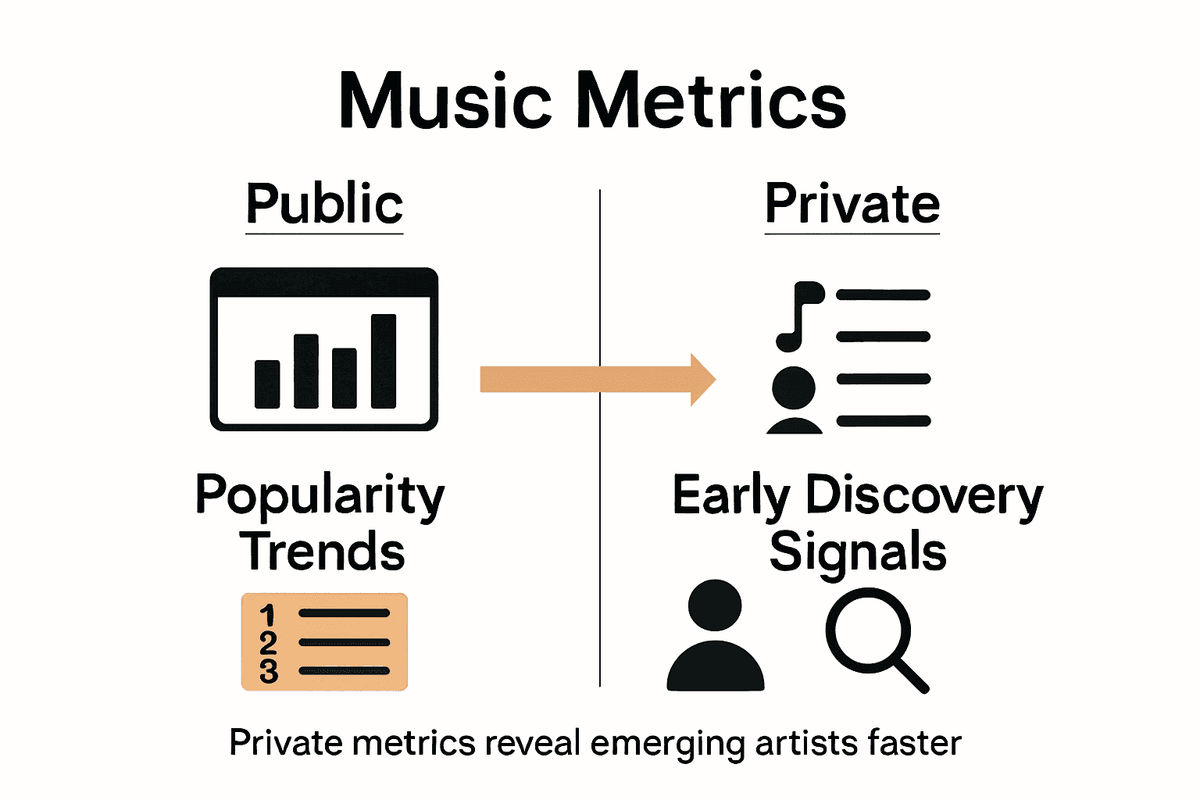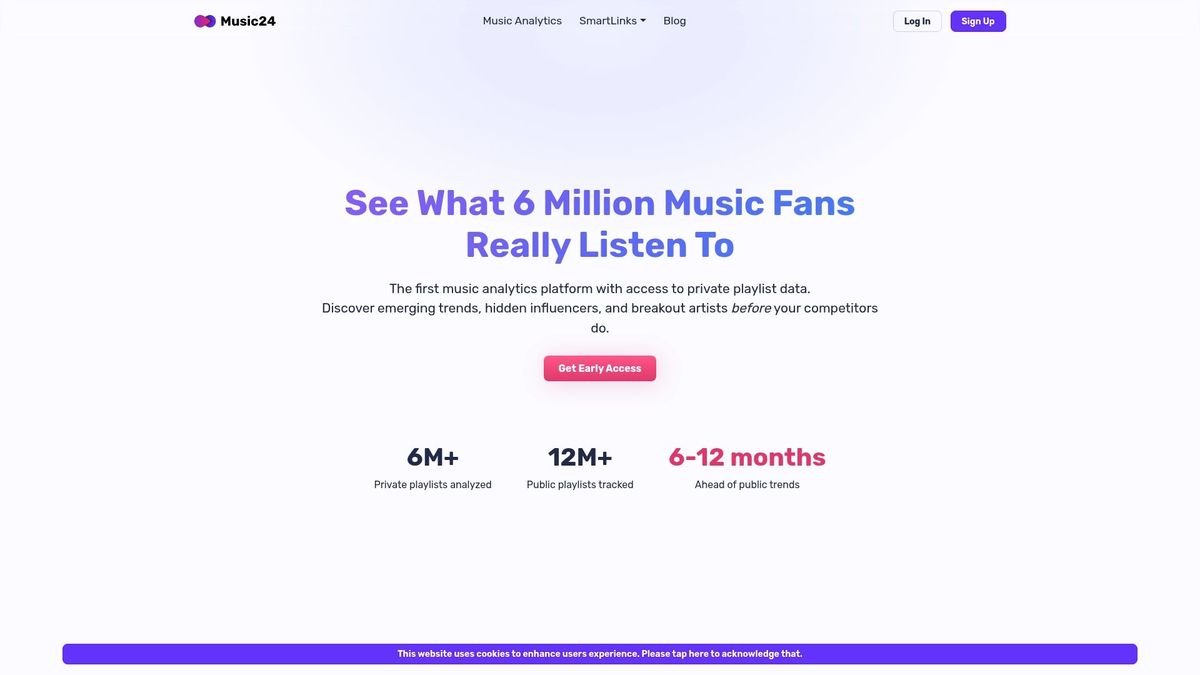Every day, over 100 million songs compete for listeners’ attention on streaming platforms. This explosion of choice raises a pressing question: how do people actually find new music that resonates with their tastes? Advances in music discovery technology now tap into vast streams of user data, combining smart algorithms and machine learning to transform how music is recommended, shared, and experienced. Modern systems do far more than suggest tracks, shaping a personalized soundtrack around each listener’s preferences and moods.
Key Takeaways
| Point | Details |
|---|---|
| Dynamic Music Discovery | Music discovery is now a personalized, interactive process supported by complex algorithms analyzing user behavior and preferences. |
| Emerging Technologies | Private playlist analytics reveal nuanced listener preferences, enabling the identification of emerging artists long before mainstream popularity. |
| Industry Applications | Music discovery technologies empower labels and marketers by providing insights for talent scouting, audience segmentation, and marketing strategies. |
| Challenges Ahead | The music industry faces risks from AI and evolving consumer behaviors, necessitating new strategies for maintaining creative integrity and revenue fairness. |
Table of Contents
- Defining Music Discovery Technology Today
- Types of Music Discovery Platforms and Methods
- How Private Playlist Analytics Drives Early Discovery
- Applications For Labels, Managers, and Marketers
- Comparing Private and Public Music Metrics
- Challenges, Risks, and Future Innovations
Defining Music Discovery Technology Today
Music discovery technology represents a sophisticated algorithmic ecosystem designed to help listeners explore new musical experiences beyond traditional recommendation methods. Understanding what drives modern music discovery requires examining how technological systems transform passive listening into active musical exploration.
According to research from a master's thesis, streaming platforms have fundamentally reshaped music discovery into an interactive process where digital services and user behaviors continuously interact. This transformation means music discovery is no longer a linear experience but a dynamic, personalized journey powered by complex algorithmic processes. The technology now filters and presents musical content by analyzing multiple data points:
- Individual listening history
- Contextual user preferences
- Real-time behavioral patterns
- Genre and mood correlations
- Social listening connections
At its core, personalized music discovery represents a socio-technical system that intelligently curates musical content. The goal is not just recommending songs, but creating a nuanced, engaging exploration experience that adapts to each listener's unique taste profile. By combining machine learning, user data, and sophisticated recommendation engines, these technologies transform how audiences encounter and interact with new music, making discovery more intuitive and personally relevant than ever before.
Types of Music Discovery Platforms and Methods
Music discovery platforms leverage diverse technological approaches to help users explore new musical landscapes. What makes these platforms unique is their ability to transform raw musical data into personalized listening experiences through sophisticated recommendation mechanisms.
Some platforms, like the Music Genome Project, employ intricate analytical techniques by breaking down songs into hundreds of musical attributes or "genes". According to research, these platforms create interactive discovery maps using complex vector matching algorithms that identify musical similarities across tracks. This granular approach allows listeners to navigate musical landscapes based on nuanced sonic characteristics rather than relying solely on genre or artist associations.
Alternative platforms focus on emotional and contextual discovery. AI-powered solutions like Moodagent demonstrate this approach by utilizing:
- Machine learning algorithms
- Signal processing technologies
- Advanced musicology research
- Emotional characteristic mapping
These platforms go beyond traditional recommendation systems by understanding music not just as sound, but as an immersive, emotionally resonant experience. By analyzing tracks through multiple dimensions - rhythm, instrumentation, mood, energy - they create highly personalized recommendation engines that adapt to individual listener preferences and contextual environments.
How Private Playlist Analytics Drives Early Discovery
Private playlist analytics represent a transformative approach in music discovery, offering unprecedented insights into listener behaviors and emerging musical trends. Learn more about leveraging playlist data to understand how these hidden musical ecosystems reveal nuanced listener preferences before they become mainstream.
Research demonstrates that repeated song exposure follows a fascinating "mere exposure effect", where listener interest dynamically rises and falls. According to studies, private playlist analytics can map these intricate discovery patterns, characterizing both user preferences and content interactions with remarkable precision. This approach allows music industry professionals to identify emerging artists and track the subtle trajectory of musical interest long before traditional metrics capture these shifts.
The most sophisticated private playlist analytics systems address critical challenges in music recommendation by implementing advanced techniques:
- Mitigating popularity bias
- Analyzing musical characteristic similarities
- Tracking granular listener behavior
- Identifying niche content potential
A groundbreaking study proposes a domain-aware fairness approach that ensures recommendations reflect genuine musical similarities rather than simply amplifying already-popular tracks. By examining private playlist data, these systems can surface hidden gems and emerging artists, creating more diverse and authentic musical discovery experiences that go far beyond conventional recommendation algorithms.

Applications for Labels, Managers, and Marketers
Music discovery technology has become a game-changing tool for music industry professionals, transforming how talent is identified, marketed, and monetized. Explore advanced music marketing analytics to understand how data-driven insights are revolutionizing strategic decision-making across the music ecosystem.
According to research, AI and advanced analytics are empowering labels, marketers, and A&R professionals by providing unprecedented insights into listener behaviors and emerging trends. These technologies analyze complex listening habits and musical characteristics, enabling professionals to identify emerging talent with remarkable precision. The combination of algorithmic insights and human curation allows for more strategic talent development and targeted marketing approaches.
Key applications for music discovery technology include:
- Trend identification and predictive talent scouting
- Personalized artist marketing strategies
- Detailed audience segmentation
- Playlist placement optimization
- Sync licensing opportunities
Moreover, music royalty securitization has emerged as a sophisticated application of these analytics. Research indicates that detailed performance data from streaming platforms now enables more accurate catalog valuations, allowing labels and investors to make more informed decisions about music assets. This data-driven approach transforms how musical intellectual property is assessed, traded, and monetized, creating new economic opportunities in the rapidly evolving music landscape.
Comparing Private and Public Music Metrics
Music metrics represent a complex landscape where public and private data intersect, offering nuanced insights into listener behavior. Explore how metrics go beyond traditional measurements to understand the sophisticated dynamics of music consumption and discovery.
Research using Last.fm data reveals that social connections profoundly influence discovery rates, with exploratory users more likely to be influenced by similarly adventurous peers. This finding highlights a critical distinction between public streaming metrics and the more intricate private social metrics that shape music exploration. Public metrics typically capture surface-level popularity, while private data uncovers the underlying social and behavioral patterns driving musical discovery.
Key differences between public and private music metrics include:
Here's a comparison of public and private music metrics:
| Metric Type | Data Scope | Insights Depth | Discovery Impact |
|---|---|---|---|
| Public | Streaming counts Chart rankings | Surface-level Popularity trends | Measures mainstream Misses niche trends |
| Private | Playlist activity User behavior | Granular Behavioral patterns | Reveals early discovery Tracks emerging artists |
- Scope of measurement
- Depth of listener insights
- Social influence tracking
- Predictive discovery potential
- Granularity of consumption patterns
While public streaming performance metrics traditionally drive investment and securitization strategies, they often overlook crucial consumption nuances. Private playlist data provides a more comprehensive view, capturing niche engagement insights and early-stage discovery dynamics that public metrics might completely miss. This granular approach allows music industry professionals to understand not just what is popular, but how and why certain music gains traction among specific listener groups.

Challenges, Risks, and Future Innovations
Music discovery technology stands at a critical juncture, balancing unprecedented opportunities with complex emerging challenges. Learn about navigating technological risks in music innovation to comprehend the intricate landscape of future music ecosystems.
According to research, the music industry faces significant risks including AI-generated music copyright complexities, evolving consumer behaviors, and increasingly fragmented consumption patterns. Platform algorithms now wield enormous power in determining artist discoverability and revenue distribution, creating unprecedented challenges for traditional music business models. This technological shift demands sophisticated strategies to maintain creative integrity and fair compensation.
Key challenges and potential innovations include:
- AI-driven music composition technologies
- Advanced personalization recommendation engines
- Virtual and augmented reality music experiences
- Shifting consumer models from ownership to access
- Social media's expanding role in viral music discovery
Future innovations are poised to fundamentally reshape how music is created, consumed, and experienced. The emerging landscape suggests a dramatic transformation where technology will not just facilitate discovery, but actively participate in music creation, blurring traditional boundaries between listeners, creators, and platforms. These developments promise more personalized, immersive, and dynamic musical interactions that transcend current technological limitations.
Discover Breakout Artists Before the World Does
Struggling to see beyond surface-level public music metrics? The article highlighted how traditional methods often miss early trends and niche audience movements. If you are tired of chasing yesterday’s charts, you are not alone. Accurate discovery now means analyzing private playlist activity, understanding micro-trends, and knowing who really influences music’s next wave. That is where real industry advantage happens.

You can be the first to spot emerging artists and influential curators with real, predictive analytics from Music24.com. Our platform uses exclusive private playlist data to reveal authentic discovery patterns before they ever appear in public charts. Want to make smarter decisions and unlock hidden opportunities? Start by exploring what makes private playlist analytics a game changer in our early discovery guide. Then visit Music24.com right now to see how actionable insights can transform your music strategy today.
Frequently Asked Questions
What is music discovery technology?
Music discovery technology encompasses algorithmic systems designed to enhance listeners' musical exploration by analyzing data points such as listening history, user preferences, and real-time behavior, transforming passive listening into a personalized experience.
How do music discovery platforms work?
Music discovery platforms utilize various methods, such as analytical techniques and AI-powered solutions, to curate personalized listening experiences based on musical attributes, emotional characteristics, and contextual information, enabling users to explore music beyond traditional recommendations.
What role do private playlist analytics play in music discovery?
Private playlist analytics provide insights into listener behavior and emerging musical trends, allowing industry professionals to identify niche content and discover new artists by analyzing unique consumption patterns that aren't visible in public metrics.
How can music discovery technology benefit music industry professionals?
Music discovery technology helps labels, managers, and marketers identify emerging talent, optimize marketing strategies, segment audiences, and enhance playlist placements, leading to more effective decision-making and enhanced monetization opportunities.


